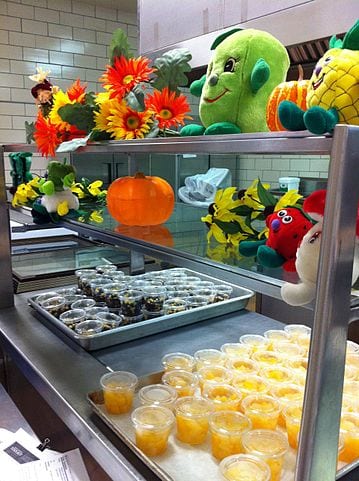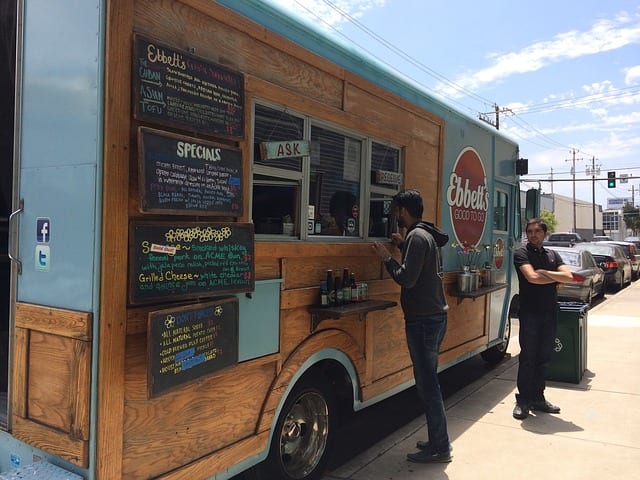If you ask my kids what their favorite part of the school day is, lunch always ranks high on the list because they get to be with their friends. For other kids though, lunch is a priority because a free cafeteria meal may be the only way they eat that day. From community gardens to cooking contests, cafeteria staff are building communities. Here are 10 ways school lunch—and the dedicated people who serve it—is about more than just food.
1. Making sure kids eat during summer

Summer can be an end to nutritious, consistent meals for students. While many districts provide summer meals, Murfreesboro City Schools (MSC) in Tennessee takes food to kids with their Combatting Hunger on Wheels (CHOW) buses. Gary Anderson, assistant superintendent of operations, adapted out-of-service buses to help serve more than 90,000 meals to students.
The CHOW buses aren’t Anderson’s first innovations in food service. In a 60 percent free-lunch district, he started a first-period free breakfast program resulting in less tardiness and absenteeism. He also started the MCS Junior Chef Academy program, a sixth grade, six-week culinary program culminating with a district-wide judged contest.
2. Showing students how to grow food

The on-site school lunch began with ’40’s farm surpluses and has come full circle through gardening initiatives like City Blossoms in Washington, D.C. and Farm 2 School in Tennessee. Kids get their hands dirty while learning about seeds, planting, regionally-sourced produce, tower gardens, hydroponics, cooking lessons, and greenhouses. Food exposure from seed-to-taste helps make previously unfamiliar produce like spinach part of daily positive eating habits.
Schools aren’t stopping with simple raised bed gardens; from the South Bronx Discovery High vertical urban gardens to Bay Haven’s use of EarthBox sub-irrigated planters, schools are constantly innovating and educating.
3. Reducing the stigma of free meals
Even though free and reduced lunch programs work to feed kids that couldn’t otherwise afford a meal, there is still a stigma attached to the identification. Across the country, school districts like Metro Nashville Public Schools remove the stigma by providing every student breakfast and lunch at no charge, no questions asked.
4. Encouraging respect around food and meals
The cafeteria atmosphere contributes to how students eat and behave during and after lunch. Schools can improve the lunchroom environment in many ways: staff trainings, parents as monitors, positive wall art, and so on. Turning a school cafeteria into a café-style experience can be as simple as changing room layout or furniture.
Posted rules and lunchroom expectations help make school lunch an opportunity for inclusion and life skill education for all students. Each activity like socializing or the lunch line mirrors real-world interactions students will experience in their personal and professional lives.
5. Eating together to create community
School lunch can be a great opportunity for increasing community involvement when you invite anyone from family to local leaders to dine with kids. Community holiday meals, “muffins for moms,” “donuts for dads” and other events invite outsiders to visit with students, building a sense of community and instilling the importance of talking over a sit-down meal. Introducing foods through multicultural food festivals can also bring together the community in the school setting.
6. Introducing kids to new foods

A love of food starts with the mouth but can continue in the classroom. My own kids eat sweet potatoes and pumpkin because it was introduced at school. In food deserts, healthy produce may not be available and may be unreachable at higher costs than processed foods. The well-supported cafeteria is a great place to introduce interesting new foods, promote healthy eating habits, and provide access to foods students might not otherwise benefit from.
7. Starting green clubs
School cafeterias can be a great opportunity to start a green club because you can demonstrate the entire process of the food cycle from farm to table to waste. You can encourage kids to reduce waste through recycling or composting with rewards for classrooms with the least waste.
8. Educating the school community

Educating students and the community about better nutrition can be integrated into every part of the school day: math, science, social studies, physical education, and health. Teaching lifelong eating habits at all levels involves teachers, food service staff, administration, students, families, and the community. Gardening and math play a dual role in learning gardens like the Denver Urban Gardens (DUG) program. Students learn the business process as they sell their produce at local farmer’s markets: from signing to table setup to responsible pricing, money management, and selling, students do it all.
9. Teaching culinary arts
High schools in districts like Arizona’s Glendale Union are returning to career and technical paths with culinary CTE programs that integrate culinary course work into related math and science courses. These are followed dual enrollment college programs or real-world internships. Culinary major high school students can even inspire younger students by working with cafeteria staff to cater events or serve.
10. Inviting food trucks to add diversity

High schools that allow students to go off-campus for lunch may see increased tardiness and absenteeism. Innovative high schools now offer new dining options through partnerships with restaurants like Chick-fil-A and food trucks on campus. Other schools have patterned their high school cafeterias after college dining halls with salad and taco bars, so that students have interesting choices without leaving campus.
What can you do to be part of the innovation of school lunch?
- Parents: Volunteer during your kid’s school lunch
- School leaders: Try one of the above innovative ideas, show your cafeteria staff appreciation, and show up at school lunch
- Anyone: Let Congress know kids deserve healthy school meals as a right, not a privilege; collect and donate healthy foods to underserved schools
Join our Facebook group Principal Life for more ideas on how to transform your school.

